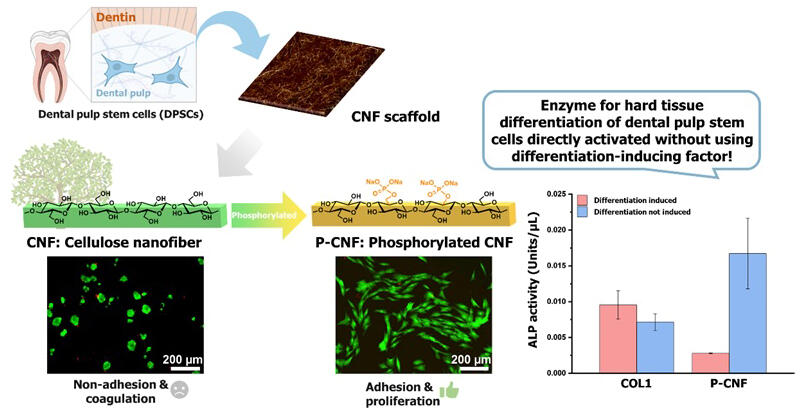Dental regenerative therapy using dental pulp stem cells obtained minimally invasively from deciduous and wisdom teeth is a radical treatment that is a groundbreaking alternative to conventional cavity filling treatments. However, this approach has faced challenges, including the use of non-human animal collagen or autologous dental materials as scaffolds for regeneration.
A collaborative research group led by Master's Student Akihiro Iwasaki (second-year) and Ms. Qimei Liu (completed master's degree in 2023) from the Graduate School of Bioresource and Bioenvironmental Sciences at Kyushu University, Assistant Professor Mayumi Hatakeyama and Professor Takuya Kitaoka from the Faculty of Agriculture at Kyushu University, Assistant Professor Ai Orimoto from Kyushu Dental University, and Professor Tomokazu Fukuda from Iwate University has successfully cultured human dental pulp stem cells by specifically introducing phosphate groups onto the surface of tree-derived cellulose nanofibers (CNFs). Furthermore, they achieved differentiation into hard tissue without adding exogenous differentiation factors. Their findings were published in Carbohydrate Polymers.

Provided by Kyushu University
The researchers focused on the "fibrous morphology" and "structural regularity of disaccharide units" of CNFs derived from trees, which can structurally mimic fibrous collagen and acidic polysaccharides with repeating disaccharide units such as hyaluronic acid—the main components of the extracellular matrix (ECM) surrounding body cells. By introducing phosphate groups to the CNF surface to create a scaffold for biomineralization, they discovered a phenomenon that enables cell adhesion, culture characteristics, and dentin-like hard tissue differentiation.
Although the original CNFs had no cell adhesion capability whatsoever, moderately phosphorylated surfaces allowed highly efficient adhesion and culture of dental pulp stem cells. They could induce differentiation into hard tissue without adding differentiation-inducing factors (such as exogenous protein components) essential for tooth regeneration. This unexpected biomaterial function of tree-derived natural polysaccharides shows promise as a novel medical modality for ex vivo tissue culture, with potential for further functional exploration.
"This research discovered that CNFs obtained from familiar trees can promote the adhesion and differentiation of stem cells in dental tissue," stated Iwasaki. "Through this research, I learned not only about the new possibilities of natural polysaccharides but also about the challenges and joy of research. I hope to continue being involved in materials and cell research and make significant strides in the future."
Journal Information
Publication: Carbohydrate Polymers
Title: Proliferation and differentiation of human dental pulp stem cells on phosphorylated cellulose nanofiber scaffolds
DOI: 10.1016/j.carbpol.2025.123593
This article has been translated by JST with permission from The Science News Ltd. (https://sci-news.co.jp/). Unauthorized reproduction of the article and photographs is prohibited.




